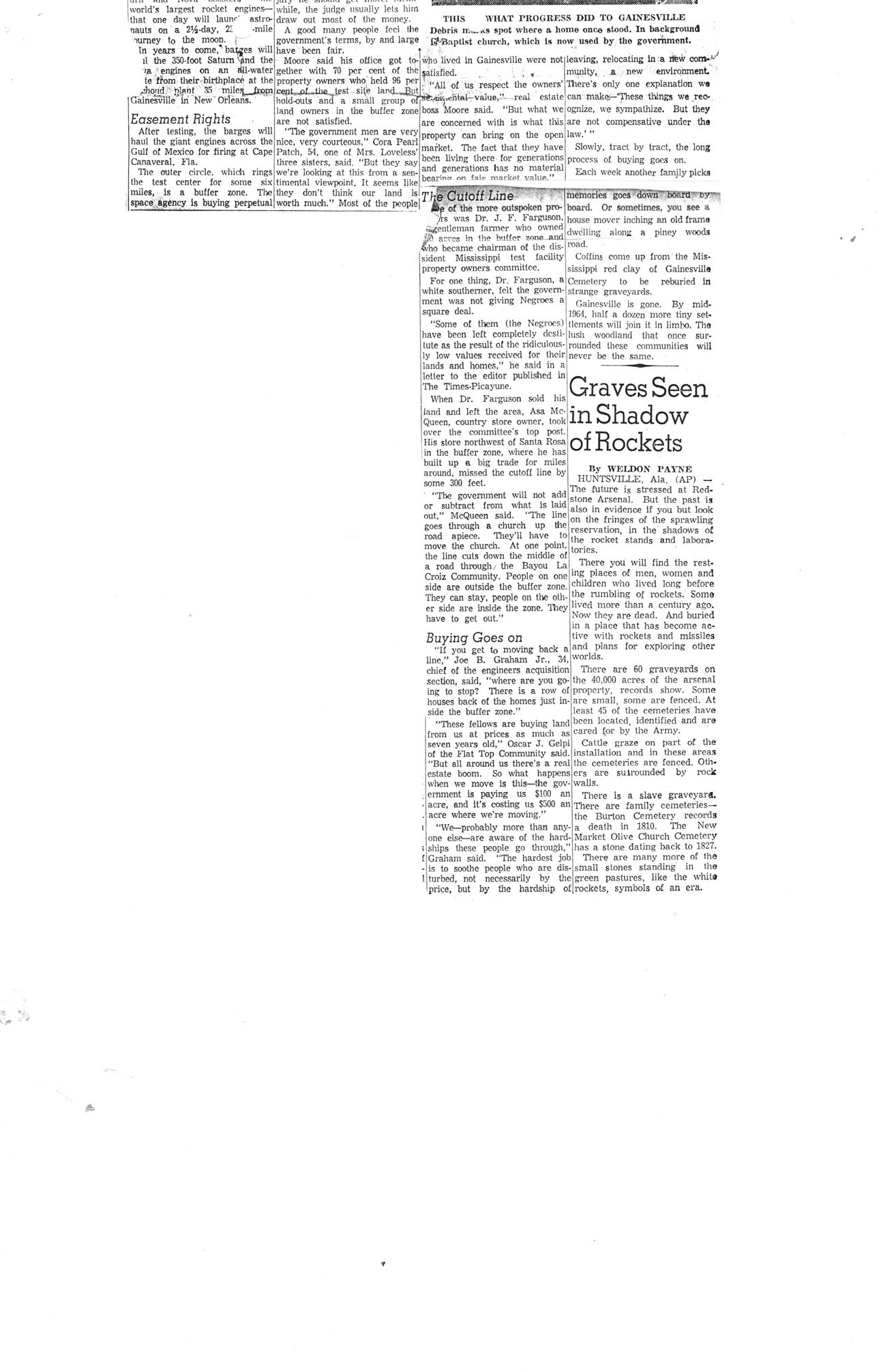This text was obtained via automated optical character recognition.
It has not been edited and may therefore contain several errors.
I world’s largest rocket engines— that one day will launr' astronauts on a 2%-day, 21 -mile lumey to the moon, f In years to come*bawes will ll the 350-foot Saturn ynd the ra '• engines on an stll-water te ftam tlieir^birthplace at the ^jhoud" jjlflnt 35 milr.^ fmyn Gainesville in New" Orleans. Easement Rig his After testing, the barges will haul the giant engines across the Gulf of Mexico for firing at Cape Canaveral, Fla, The outer circle, which rings the test center for some six miles, is a buffer zone. The space agency is buying perpetual SBWBraffl while, the judge usually lets him draw out most of the money. A good many people feel the government’s terms, by and large have been fair. Moore said his office got together with 70 per cent of the property owners who held 96 per cepWif.-llip test si\e land—But|v hold-ouls ana a small group " land owners in the buffer zone are not satisfied. “The government men are very nice, very courteous,” Cora Pearl Patch, 54, one of Mrs. Loveless’ three sisters, said. “But they say we’re looking at this from a sentimental viewpoint. It seems like they don’t think our land is worth much.” Most of the people THIS WHAT PROGRESS DID TO GAINESVILLE Debris it._as spot where a home once stood. In background Isf-Baptist church, which is now used by the government. who lived in Gainesville were not ^atisfied. , ■„ , , “All of us respect the owners' ,<?htai-r-vakie,'-real estate boss Moore said. “But what we are concerned with is what this property can bring on the open market. The fact that they have been living there for generations and generations has no material b€rlPnrr fair markpt value.” leaving, relocating in a riew conv^ munity, a new environment. There's only one explanation wa can makes—"piese things we recognize, we sympathize. But they are not compensative under the law.’ ” Slowly, tract by tract, the long process of buying goes on. Each week another family picks The Cutoff Line ■> Jfe of the more outspoken promts was Dr. J. F. Farguson, gentleman farmer who owned acrcs in the buffer zone and I ho became chairman of the dissident Mississippi test facility property owners committee. For one thing, Dr. Farguson, a white southerner, felt the government was not giving Negroes a square deal. "Some of them (the Negroes) have been left completely destitute as the result of the ridiculously low values received for their lands and homes," he said in a letter to the editor published in The Times-Picayune. When Dr. Farguson sold his land and left the area, Asa McQueen, country store owner, took over the committee's top post. His store northwest of Santa Rosa in the buffer zone, where he has built up a big trade for miles around, missed the cutoff line by some 300 feet. “The government will not add or subtract from what is laid out,” McQueen said. “The line goes through a church up the road apiece. They’ll have to move the church. At one point, the line cuts down the middle of a road through/ the Bayou La Croiz Community. People on one side are outside the buffer zone. They can stay, people on the other side are Inside the zone. They have to get out.” Buying Goes on “If you get to moving back a line,” Joe B. Graham Jr., 34, chief of the engineers acquisition section, said, “where are you going to stop? There is a row of houses back of the homes just inside the buffer zone.” "These fellows are buying land from us at prices as much as seven years old,’’ Oscar J. Gelpi of the Flat Top Community said. “But all around us there’s a real estate boom. So what happens when we move Is this—the government is paying us $100 an acre, and it’s costing us $500 an acre where we’re moving.” “We—probably more than anyone else—are aware of the hardships these people go through,” f Graham said. “The hardest job is to soothe people who are disturbed, not necessarily by the price, but by the hardship of fn&noi&s"goeA ?3dwri” board- Dy~" board. Or sometimes, you see a house mover inching an old frame dwelling along a piney woods road. Coffins come up from the Mississippi red clay of Gainesville Cemetery to be reburied in strange graveyards. Gainesville is gone. By mid-1964, half a dozen more tiny settlements will join it in limbo. The lush woodland that once surrounded those communities will never be the same. Graves Seen in Shadow of Rockets By WELDON PAYNE HUNTSVILLE, Ala. (AP) — The future is stressed at Redstone Arsenal. But the past is also in evidence if you but look on the fringes of the sprawling reservation, in the shadows of the rocket stands and laboratories. There you will find the resting places of men, women and children who lived long before the rumbling of rockets. Some lived more than a century ago. Now they are dead. And buried in a place that has become active with rockets and missiles and plans for exploring other worlds. There are 60 graveyards on the 40,000 acres of the arsenal property, records show. Some are small, some are fenced. At least 45 of the cemeteries have been located, identified and are cared (or by the Army. Cattle graze on part of the installation and in these areas the cemeteries are fenced. Others are suArounded by rock walls. There is a slave graveyara. There are family cemeteries— the Burton Cemetery records a death in 1810. The New Market Olive Church Cemetery has a stone dating back to 1827. There are many more of the small stones standing in the green pastures, like the whila rockets, symbols of an era.

Logtown Town loses fight to survive, SCE 1963 (2)